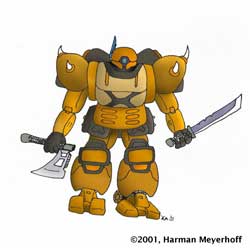
| APAGear II Archives | Volume 3, Number 6 | July, 2001 |


Click on image to view larger version (31 kB).
Surrounded by a reputation on par with its mythical namesake, the Sand Phoenix is as rare as it is fierce, endowed with unique habits that not only make it unquestionably one of the strangest beasts to inhabit Terra Nova, but also allow it to survive the hostile conditions of the Great White Desert. Simply put, the Sand Phoenix is the only creature known to directly use white sand as an offensive weapon.
In appearance, the Sand Phoenix is somewhere between a Toussain (Dak) and a rhinoceros beast, though only the size of a large cat. Covered with a layer of iridescent pearly-white scales and with two ribbed "wings" (similar to those found on species of gliding terran tree lizards) running the length of its sides, the Phoenix seems a pretty and harmless desert animal when merely gliding the desert thermals or basking. However, such sightings are rare, mostly due to the particular habits of this strange beast.
Endowed with sebaceous glands that apparently produce a chemical defense against the corrosive effects of white sand and covered in a thick armored hide, the Phoenix is one of the few animals capable of actually living in areas rife with these dangerous ash deposits. Indeed, white sand is one of the primary necessities for this rare lizard, providing both defense and an offensive weapon.
On the rare occasions where a Phoenix is surprised, or more commonly spots prey, it will quickly burrow into the nearest patch of white sand, covering all of its exposed soft tissues with flaps of corrosion-resistant scale and "swimming" to a depth of ten to twenty centimeters. Once concealed, the Phoenix will remain inert in a sort of short-hibernation mode, conserving oxygen until such time as vibrations in the sand indicate danger or food is imminent. At that point, the Phoenix will leap up from cover and rapidly fan and kick up a large cloud of blinding, stinging, corrosive white sand. With the victim incapacitated, the Phoenix will then either take the opportunity to flee or bite. If it chooses to attack, it not only can kill with the severe burns to the lungs and mucous membranes caused by inhaled white sand dust, but also bite the prey with its venomous bottom fang. Unfortunately, the innards of the Phoenix are no more resistant to the adverse effects of the corrosive ash than any other animal, and as such it will immediately try to drag the meat to clean ground and scratch off the worst concentrations of white sand before consumption.
After careful records combing, scientists have found a remarkable account of a Maxwell gunner on a reconnaissance hovertank squadron. While patrolling an area of the Karaq wastes, the squadron noticed many small white flying lizards circling an area in the distance. When his tank was ordered to investigate, he claims the lizards fled. A short time later the tank reached the location of the phantom fliers and found a small depression filled with fine white sand. The Minerva pilot noticed in time and vectored away, narrowly averting stirring up the corrosive dust and sucking it into the fragile turbines. However, the Maxwell claimed that the dune itself began to vibrate "like a 24mm rifle on automatic", fanning the dust into the tanks path. The corrosive cloud was immediately ingested by the movement system, despite an emergency VTOL jump, and the subsequent midair failure and crash killed the rest of his crew. The Maxwell in question only escaped the wreck out of sheer luck, suffering third-degree burns across much of his body, and white-sand scarring to one eye and much of his nasal passages from the dust still floating in the air.
Fortunately, Sand Phoenixes are extremely rare, and have never been spotted outside the Great White Desert. A possibly related species of lizard called the "Tempest Snake" or "Sand Wyvern", that uses far less lethal silicate sands as a its defense mechanism, but retains the venom fang. Among the Koreshi of the Great White, Sand Phoenixes are considered the greatest of good luck signs, and the sight of these soaring lizards near vegetation or MacAllen tunnel wells has only helped reinforce the superstition.
With the proliferation of ground-effect craft such as WotA and NuCoal hovertanks, Paxton Sand Cobra couriers, and even the smaller landships, a Phoenix colony can cause horrendous troubles, resulting in ample desert-survival plots, rescue missions and the like. Their superstitious status with the Koreshi can be both bane, blessing, and even a quest hook, as could the involvement of wildlife and neoarchaeology researchers from both or either poles. It is even rumored that the commander of a southern regiment (the 17th Sand Demons) is actively seeking a live specimen as a mascot. And the relatively harmless but frightening Tempest Snakes can always become a useful background fauna (or painful surprise) in a badlands adventure.
| AGI +3 | BLD -5 | FIT 0 | INS +1 | PER +2 |
| WIL 0 | STR -2 | HEA 0 | STA 10 | UD 1* |
*(+ natural weapons)
| Skills | Skills | Skills | Skills |
| Camouflage 3/+2 | Combat Sense 2/+2 | Dodge 2/+3 | Hand-to-Hand 2/+3 |
For vehicle combat a colony should be considered equivalent to one squad of light infantry (Lvl 2, no armor). Assume a weapon Range of 0/0/0/1 and a DM of x3 with AE=0 and White Sands ammo (on an even attack roll, target loses an extra point of armor).
| APAGear II Archives | Volume 3, Number 6 | July, 2001 |
Heavy Gear is © 2001, Dream Pod 9, Inc. All rights reserved. APAGear is not affiliated with Dream Pod 9 in any way. Submitted material remains the property of the creator.